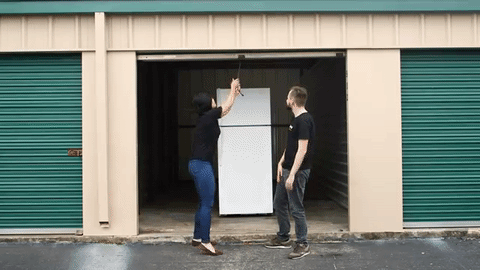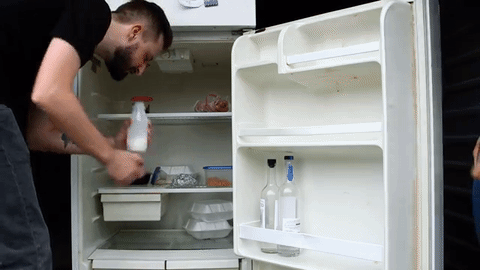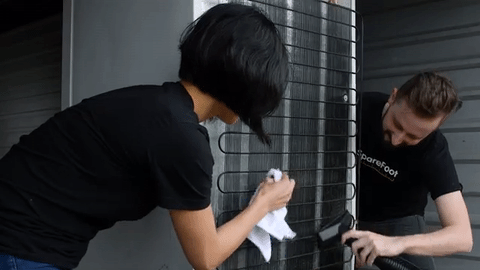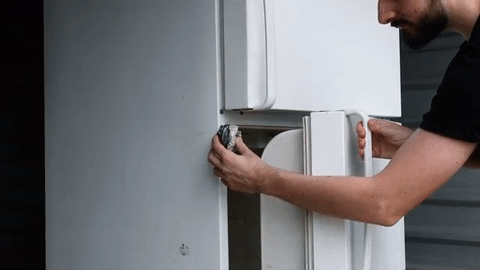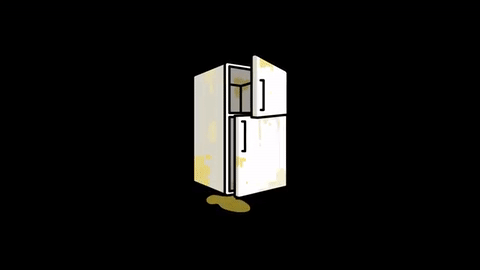A refrigerator is one of the most common appliances that people need to put inside of a self-storage unit.
Luckily, storing a fridge is relatively straightforward, but it’s important to take the necessary precautions to avoid contamination from mold, undesirable smells, and pests. Because refrigerators and freezers retain moisture, you’ll need to take some extra care and precautions when placing your refrigerator into short or long-term storage.
Choose the Right Storage Facility
An amenity that you want to look for is a storage unit drive-up access. If you search for self-storage on SpareFoot, you can restrict the search to only show storage units with this feature.
- Because a fridge can be permanently damaged by dropping or leaning it too far on its side (more about that later), you’ll want to avoid having to execute any tricky maneuvers to get it into storage. A unit at the top story of an indoor storage complex might not be the best choice.
- Choose a self-storage facility with climate-controlled units. Units with climate control have regulated air temperatures and humidity making them better suited to storing refrigerators. Fluctuations in humidity levels can create prime conditions for mold or mildew growth.
- When it comes to unit sizes, you’ll probably need at least a 5×10 self-storage unit. A 5×5 would not leave wiggle room for positioning the appliance, and the doors may be too narrow as well.
[well type=””]Find self-storage discounts near you
[/well]
Storage tip: Storing at a facility with drive-up access will minimize the distance moved, and thus minimize the risk of damage.
Defrost and Clean
If you clean your fridge or freezer poorly before storing, it could result in such a mess that your appliance will be unusable by the time you retrieve it from storage.
One concern is mold, which can start with food debris and spread through the rest of the refrigerator. Mold is a concern even in a clean fridge, though it’s more likely if you’re storing a dirty one. Another concern is pests. Ants and rodents can be attracted to even the smallest bits of food, and they could damage the electronic components of the fridge.
Defrost
Ready to start defrosting your refrigerator? Here’s how:
- Remove all food from all compartments and unplug the appliance. This begins the defrosting process to begin.
- Keep the refrigerator doors open while defrosting so that moisture can escape from inside of the fridge.
- Place a towel strategically to catch any dripping water.
- To ensure that the refrigerator is completely dry, you should defrost for a week before storing.
Clean
While the fridge is defrosting, you can clean out the inside and back of the appliance.
- Take out any drawers, shelves and other removable parts.
- Clean or soak these with mildly soapy water— just be sure to remove all food debris. Only use warm water. Scalding hot water can cause the cold plastic or glass to crack.
- Use a mixture of baking soda and water (a couple tablespoons per quart) to scrub away any build-up on the inside of the refrigerator and freezer compartments.
- Do not use ammonia, chlorine bleach or other abrasive cleaning solutions, as they can crack or discolor both plastic and stainless steel.
- If you haven’t already, pull the fridge out of its nook or compartment so you can access the sides and rear.
- Wipe the outside down with mildly soapy water. Dust the coils on the back of the machine, either with the brush attachment of a running vacuum cleaner or just a dry cloth.
- Disconnect the drainage line from the wall for the remainder of the defrosting period.
To reiterate, here are the two most important take-aways:
- First, you’re going to need to defrost for at least a week.
- Second, use mild detergent water on the outside of the unit, shelves and drawers, but only use baking soda and water on the inside compartments.
Moving Your Refrigerator
A failed compressor is a common cause of broken refrigerators, and moving a fridge can instigate the issue. When moving and storing your refrigerator, try to minimize tipping and keep your fridge upright at all times.
- Use a dolly or hand truck to move your fridge— don’t try to muscle it with two people.
- Do not move or store the fridge laying on its side.
- If you do angle it while moving in our out (you’ll likely have to, to get it into a truck), let the unit sit for at least 48 hours before plugging it in again.
Here’s a quick technical breakdown of why this occurs:
In modern fridges, high-pressure gas is moved to the condensor as the compressor runs. When tipped over, actual fluids (not gas) will run from the compressor to the condenser. Once the appliance is returned to its proper position, the tubing won’t allow all the oil to run back into the compressor where it belongs. When the compressor is started with oil in the condenser, it’s pushed further back into the condenser coil and onto the evaporator. There, it becomes cold and viscous. It will be unable to return home to the compressor, which fails due to lack of oil.
Keeping Your Refrigerator Dry
The last thing you want is to reverse all your hard work spent cleaning, defrosting and carefully moving the fridge, by allowing it to get moist inside. At worst, you’ll have mold and mildew, rendering the fridge useless without a serious cleaning later. At best, you’ll get a lingering funk in the fridge that will affect the taste and smell of your food. Not exactly a win-win.
The best way to avoid this is to completely remove the doors on both the refrigerator and freezer compartments. Follow the instructions in the user manual. You can keep the hardware in a plastic bag inside the fridge. Doing so prevents even the slightest seal to form.
The next best way to do this is to leave each door open slightly by wedging an object in between the door and the compartment frame. This is less desirable because the object might end up bending, indenting or otherwise damaging the seal that ensures the door is fully shut while in use. To help prevent this, choose a smooth, flat object (like a 4″ x 1″ board) as your wedge.
Storing a Fridge
If you follow these steps, you should have a clean and stink-free fridge that’s ready to use when you retrieve it from the unit. Remember to wait 48 hours before plugging it back in to avoid damaging the compressor.
